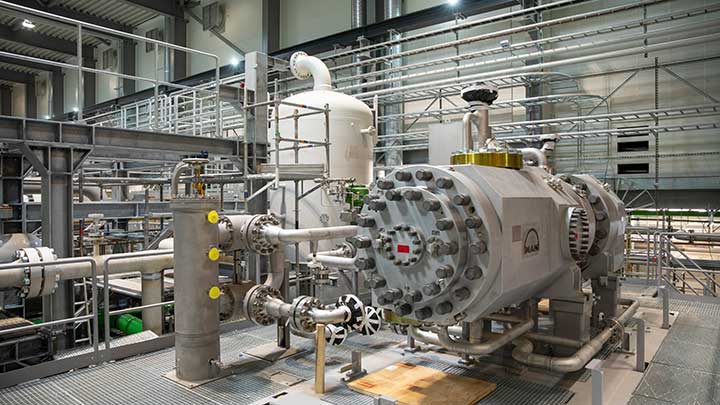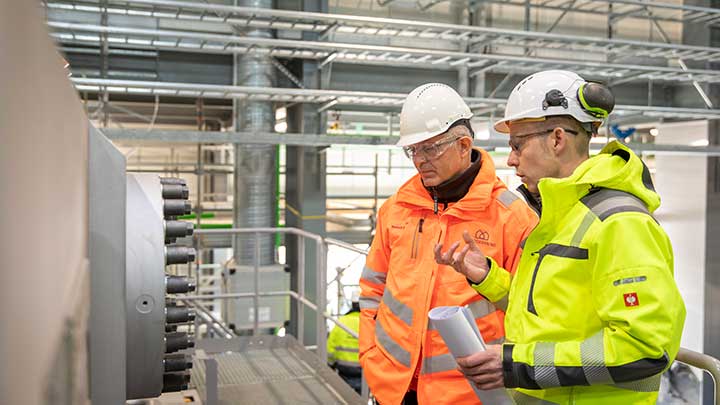They wanted to move a giant step closer to net zero. So, they built a model heat pump project for green district heating.
With an innovative green solution that will help the town of Esbjerg, Denmark, decarbonize by 2030, utility company DIN Forsyning will be using two industrial-sized heat pumps to provide their customers with heat from a vast resource right of their coast: the Wadden Sea. Discover sent independent journalist Niels Anner onsite to the Esbjerg Harbor to have a firsthand look at the project and how it works.
By Niels Anner
The weather in the harbor is rough this early spring day, but locals say it is commonplace for the town’s often raw and windy west coast. Heat matters here in Esbjerg, Denmark. Winters can be cold and long, with the sun setting in the early afternoon
and temperatures hovering just around freezing before suddenly dropping.
So, to heat homes and buildings the town has been sending heat generated from a coal-fired plant and a waste incinerator through pipes in its underground district heating network. But now that’s about to change – with a new heat pump solution
that will decarbonize the town’s heating and help balance the grid.
The key? Seawater.
We’re phasing out coal-fired heat and replacing it with carbon-neutral district heating produced from wind and seawater.
"We’re phasing out coal-fired heat and replacing it with carbon-neutral district heating produced from wind and seawater,” says Kenneth Jørgensen, Project Director at the utility company DIN Forsyning, which serves nearly 100,000 people in the greater Esbjerg area. “The switch will save around 120,000 tonnes of CO2 emissions per year and support Denmark’s effort to integrate electric renewables into the grid.”
The world’s largest supercritical heat pump
The new fossil-free technology, lies in a sleek, black industrial building just behind the harbor, where two ETES heat pump systems, supplied by MAN Energy Solutions, will harness heat directly from the Wadden Sea – a fitting approach for a city whose economy and business has been shaped for centuries by the sea, first as a main fishing port, later through oil and gas exploration, and more recently through wind power.

The modern heat pump hall near the Esbjerg Harbor houses the world’s largest seawater heat pump, which replace coal-fired heat coming from the plant in the back. The town has ambitious plans to decarbonize by 2030. ©Sebastian Vollmert
Not far away is a facility where huge rotor blades await shipment to the wind farms out in the sea, and electricity for the heat pumps will be generated by giant offshore windfarms producing an abundance of clean energy. With a heating capacity of 60
megawatts, the system is the world’s largest heatpump to use supercricital carbon dioxide (i.e., CO2 pressurized and heated above its critical point). And it is the first of its kind to provide thermal energy – that is, the transfer of
heat – on a major industrial scale.
Workers are busy at welding as Kenneth Jørgensen and Karl Böhle, MAN’s Senior Project Manager, take a tour of the heat pump hall. The ceilings are high. There are kilometers of pipes on several floors, huge gray ones that will send 4,000 liters of seawater per second surging into the system, and green ones that lead out of the building to the district heating. Today, additional components are being installed between the core parts of the new heat pump system – the compressors, expanders and heat exchangers.
"The mechanical installation is almost complete Both the seawater system and the district heating system are commissioned and ready for service," says Jørgensen, "and next heating season in autumn it all goes into operation."

At the heart of the two new heat pumps are the hermetically-sealed compressors with variable high-speed motor drives, extremely compact and durable enough to be installed under water or in arctic or desert conditions. ©Sebastian Vollmert
It’s a solution that supports decarbonization efforts and can be used not only for district heating but also industrial processes worldwide.
From seawater to district heating: how the heat pump works
“The plant is like a reverse air conditioner,” says Böhle, “but instead of cooling a building, we’re using renewable electricity to extract heat from seawater and multiply it for the distict heating network. It’s a solution that supports decarbonization efforts and can be used not only for district heating but also industrial processes worldwide.”

Karl Böhle, Senior Project Manager at MAN Energy Solutions, talks with Kenneth Jørgensen about the high-speed electrical motor the heat pumps use to quickly ramp up or down electricly consumption. ©Sebastian Vollmert
To generate heat, seawater is drawn from the harbor basin and thermal energy extracted before it is pumped back into the sea, explains Jørgensen. CO2, the refrigerant used in the process, is warmed up by the seawater and vaporized, then compressed, reaching temperatures high enough to boil hot water. “So, the heat, which is produced here in the green pipes you can see in the back, is actually delivered into our district heating system and we pump it in another pumping station to our customers.”
"The specialty of the system we’re installing is that we’re using seawater as a heat source, CO2 as a refrigerant and a hermetically-sealed, electrically-driven compressor to generate heat,” says Böhle. “One of the unique features of this heat pump solution is that its use of excessive wind power can balance the grid if required.”

Kilometers of pipes in the hall take in seawater, 4,000 liters per second, to extract heat and send it to DIN Forsynings district heating network.
Sector coupling and new grid balancing services with a heat pump
By coupling power generation with heat distribution, the system can use excess wind or solar power, convert it to heat that can be stored and sent to their customers on days with little sun or wind. “Wind turbines and solar can change their production very fast,” says Jørgensen. “So, somebody has to balance the grid, and that was very important to us that we could provide a balancing service to the grid.”
Being able to store and later use heat means that the heat pump’s production does not have to match its consumption, unlike an electrical grid where consumption and production always have to be in balance. “The heat pump system can actually change its electrical consumption,” says Jørgensen. “This we can sell to the grid as a service for integrating further renewable energy. So, we can help grid operators provide better electrical services, and at the same time we deliver clean, cheap heating to our customers."

The heat pumps will be run on electricity from a nearby windfarm and includes storage tanks for heat on days with little or no wind. ©Sebastian Vollmert
Protecting an UNESCO World Heritage Site
When looking at potential heat pump solutions, DIN Forsyning considered three refrigerants, says Jørgensen. “One was ammonia. One was the synthetic and one was CO2, which is a natural refrigerant and when it came down to factoring all the benefits, especially from the environmental point of view, CO2 was preferred. It’s a natural part of nature. And if it would leak, it would just go into the carbon cycle of the sea.”
Given the location next to the Wadden Sea, a UNESCO World Heritage Site and National Park, the need to use a non-toxic and safe-working fluid with a high heat capacity was vital. And when planning the project, DIN Forsyning had to negotiate intensively with NGOs and authorities in Denmark, Germany and the Netherlands.
DIN Forsyning serves some 100,000 customers in the greater Esbjerg area, which has been shaped for centuries by the Wadden Sea. In 2014, the Danish part of the sea was inscribed on UNESCO’s World Heritage List. ©Sebastian Vollmert
Seawater, however, is not the only heat source heat pumps can use – wastewater, ambient air or industrial waste heat are also options, making the heat pump solution flexible. “If you want to add a heat pump as part of your district heating production, you need to make it absolutely clear where you’re getting the heat from. This is the first question you have to answer and, of course, the electricity has to match your demands. “
He adds that “there are a lot of benefits and a lot of sites in the world where using a heat pump makes sense. With the increasing amount of renewables being integrated into the grid and the increasing demand for district heating, as well as a trend to replace natural gas in heating, the potential for heat pump is very high.”
About the author
Niels Anner is an independent journalist based in Copenhagen, who writes on business, science, technology and society in Northern Europe.
Explore more topics
-

The latest-generation wind turbine installation vessel
A new wind turbine installation vessel with a customized-engine configuration lets offshore wind contractor Cadeler transport and lift more powerful turbines in even rougher locations – and they’re saving emissions while they are at it.
-

Hapag Lloyd LNG container vessel
Hapag-Lloyd’s new LNG-powered containership cuts emissions by a quarter immediately and by 95 percent with green methane
-

Heidelberg Materials: First CCS plant for cement industry
The first CCS facility for cement production in Brevik, Norway, is paving the way for carbon-neutral industrial processes.
MAN Energy Solutions is now Everllence.
We have adopted a new brand name and moved to a new domain: www.everllence.com. This page will also be relocated there shortly. We are working on shifting all pages to www.everllence.com.
